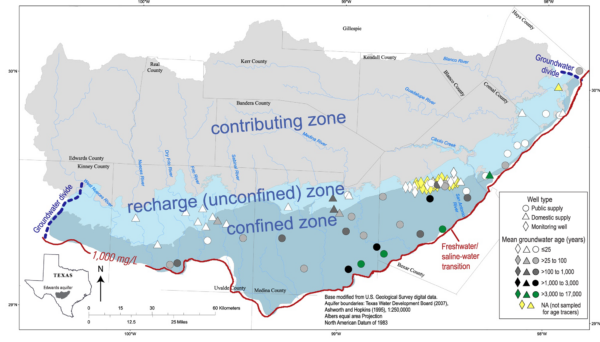
Summary of findings from Musgrove and others, 2023
Understanding groundwater contamination risks is crucial for best resource management practices. Karst groundwater supplies, such as the Edwards aquifer of central Texas, are formed by the dissolution of soluble limestone rocks, and are an invaluable part of the world’s drinking water. Yet karst processes, such as rapid recharge and conduit flow, make these aquifers highly complex and vulnerable to contamination by human activities.
Estimates of groundwater age provide direct insight into the vulnerability of groundwater to contamination. Groundwater that is relatively young, or contains a component of recent recharge is more vulnerable to potential contamination from the land surface. Although groundwater age cannot be directly measured, environmental tracers associated with recharge water are used with analytical methods of idealized tracer transport to interpret the age of a groundwater sample. When calibrated to tracer data, these analytical models estimate the age distribution of water comprising a groundwater sample, as well as the mean age; all groundwater samples are a mixture of water of different ages. As tools and techniques for estimating groundwater age have become both more sophisticated and available, their application has demonstrated unique value in understanding aquifer systems, and in particular, for assessing aquifer vulnerability.
This study uses groundwater ages in combination with other geochemical tracers for the Edwards aquifer to assess how vulnerable the aquifer likely is to contamination from human activities on the land surface. Samples from 60 wells across the San Antonio segment of the aquifer were collected between 2017 and 2018 and analyzed for a suite of age tracers; sampled wells were a combination of monitoring wells, domestic supply wells, and public supply wells.
Some key findings are:

A map of the San Antonio segment of the Edwards aquifer showing: